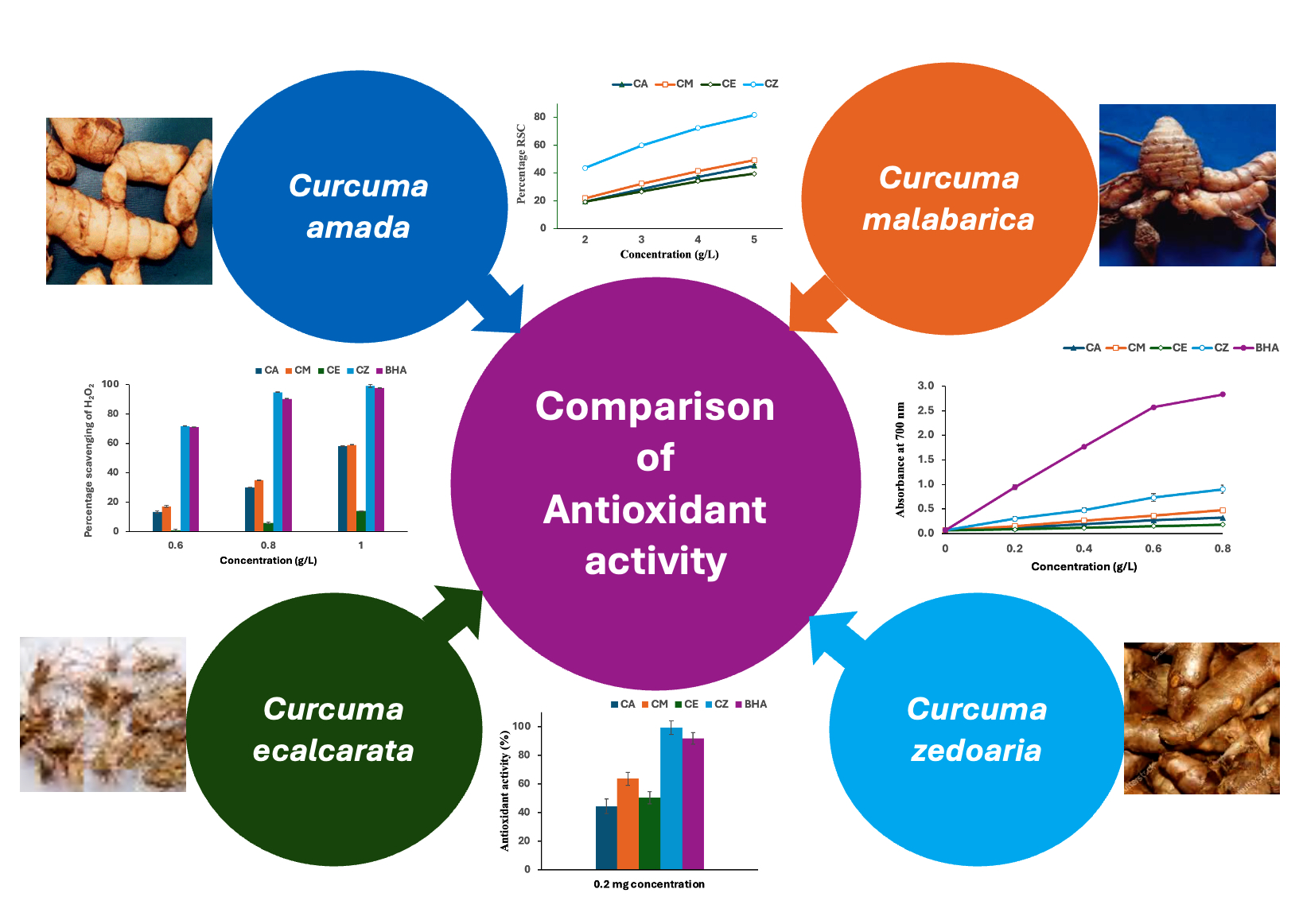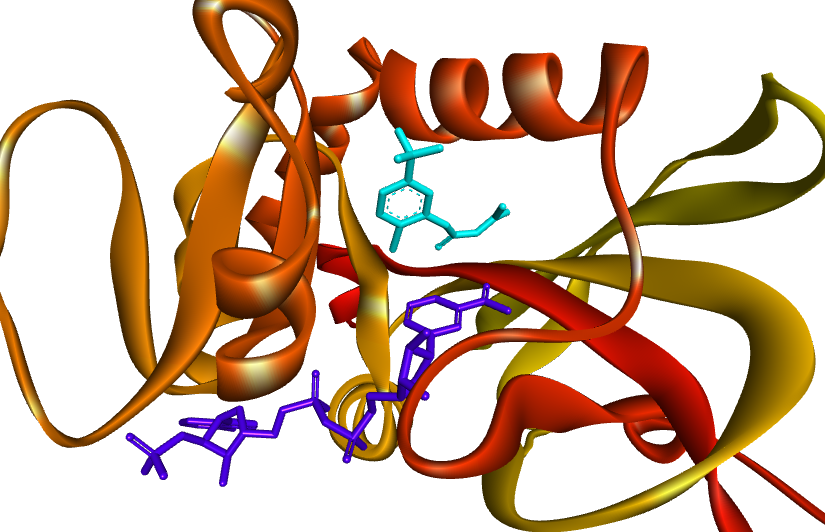
 ETFLIN
Notification
ETFLIN
Notification
Sciences of Phytochemistry (Sci. Phytochem.) is an international, peer-reviewed journal published by ETFLIN, dedicated to advancing research in all aspects of phytochemistry and plant-derived bioactive compounds. The journal provides a platform for the dissemination of original research, reviews, and scientific communications that explore the chemistry, biological activities, and applications of natural products derived from plants. We welcome contributions that deepen the understanding of the chemical diversity of plants and their potential in pharmaceuticals, nutraceuticals, agriculture, cosmetics, and environmental sustainability.
Sciences of Phytochemistry covers, but is not limited to:
Prof. Samir Chtita, Ph. D.
Department of Chemistry, Université Hassan II de Casablanca, Morocco
Google Scholar Scopus Research Gate
Managing Editor
Bharath Kumar Chagaleti, Ph. D.
Department of Pharmaceutical Chemistry, SRM College of Pharmacy, SRM Institute of Science and Technology, Tamil Nadu, India
Google Scholar
Our editors bring a diverse range of knowledge, skills and experiences to the table, enabling us to provide a broad perspective on various topics.
Prof. Dr. Emad Mohamed Abdallah
Department of Biology, College of Sciences, Qassim University, Saudi Arabia
Google Scholar ResearchGate
Prof. Bethsebie Lalduhsaki Sailo, Ph. D.
Department of Biosciences and Bioengineering, Indian Institute of Technology Guwahati (IITG), Guwahati, Assam 781039, India
Google Scholar Scopus ResearchGate
Jonathan Lalsiamthara, Ph. D.
Molecular Microbiology & Immunology, School of Medicine, Oregon Health & Science University, Portland, Oregon, USA
Google Scholar Scopus ResearchGate
Mohnad Abdalla, Ph. D.
Pediatric Research Institute, Children’s Hospital, Shandong University, Jinan, China
Google Scholar Scopus ResearchGate
Centre for Biotechnology and Bioinformatics, Dibrugarh University, Assam, India
Google Scholar Scopus ResearchGate
Dr. Fanai Nghakliana
Department of Zoology, Mizoram University, Mizoram, India
Google Scholar Scopus ResearchGate
No Announcement Yet
The reviewer's name will automatically appear in this list after they agree to be visible as a reviewer of an article in our peer review submission system. The names are ordered by the date of their latest contribution in real time. This makes the number and order of reviewers in this list dynamic.
Dr Charles Fokunang (Google Scholar)
University of Yaoundé IPHARMACOTOXICOLOGY AND PHARMACOKINETICS
Dr Jalaluddin Khan (Google Scholar)
Microbial & Pharmaceutical Biotechnology Laboratory (MPBL), Department of Pharmacognosy & Phytochemistry, School of Pharmaceutical Education and Research (SPER), Jamia Hamdard, New Delhi, 110062, India
Dr Avinash Gangal (Google Scholar)
Department of Chemistry, School of Physical Sciences, DIT University, Mussoorie Diversion Road,Uttarakhand, Dehradun, 248009, India
Dr Biryomumaisho Justus Murokore (Google Scholar)
Department of Biochemistry Faculty of Medicine Mbarara University of Science and Technology, P.O. Box 1410, Mbarara, Uganda
Dr Nurfatimah Mohd Thani (Google Scholar)
Department of Food Sciences, Faculty of Science and Technology, Universiti Kebangsaan Malaysia (UKM), Selangor, Bangi, 43600, Malaysia
Dr Sri Widyarti (Google Scholar)
Biology Department, Faculty of Mathematics and Natural Sciences, University of Brawijaya, East Java, Malang, 65145, Indonesia
Dr Isabel Lim Fong (Google Scholar)
Department of Paraclinical Sciences, Faculty of Medicine and Health Sciences, Universiti Malaysia Sarawak, Sarawak, Kota Samarahan, 94300, Malaysia
Dr Vardhana Janakiraman (Google Scholar)
Department of Biotechnology, School of Life Sciences, Vels Institute of Science Technologyand Advanced Studies, Chennai
Dr Saif Saleh Mohsen Ali (Google Scholar)
Department of Biochemistry, The Maharaja Sayajirao University of Baroda, Gujarat, Vadodara, 390002, India
Dr Aisha Shitu Sa'id (Google Scholar)
Department of Microbiology, Faculty of Life Sciences, Modibbo Adama University, Yola, Adamawa State, Nigeria
Dr Rita Hairani (Google Scholar)
Department of Chemistry, Faculty of Mathematics and Natural Sciences, Mulawarman University, East Kalimantan, Samarinda, 75123, Indonesia
Dr Ikponmwosa Owen Evbuomwan (Google Scholar)
Department of Biochemistry, Landmark University, Ipetu Road, PMB 1001, Omu-Aran-251101, Nigeria
Dr Rita Kartika Sari (Google Scholar)
Department of Forest Products, Faculty of Forestry and Environment, IPB University, Bogor 16680, Indonesia
Dr Omowunmi Femi-Akinlosotu (Google Scholar)
Developmental Neurobiology and Forensic Anatomy Unit, Department of Anatomy, University of Ibadan, Ibadan, Nigeria
Dr Azizollah Khormali (Google Scholar)
Department of Chemistry, Faculty of Basic Sciences and Engineering, Gonbad Kavous University, Gonbad Kavous, 49717-99151, Iran
Dr Yohannes Misskire (Google Scholar)
Departemen Kimia, Universitas Debre MarkosLembaga akan terbuka di tab baru, PO Box 269, Debre Markos, Etiopia
Dr Alsayed E. Mekky (Google Scholar)
Botany and Microbiology Department, Faculty of Science, Al-Azhar University, Cairo 11884, Egypt
Prof Vijay Nigam (Google Scholar)
Rajiv Gandhi Proudyogiki Vishwavidyalaya, Bhopal, Madhya Pradesh, India
Dr O.J Enema (Google Scholar)
Department of Pharmacognosy and Natural Medicine, Faculty of Pharmacy, University of Uyo, Uyo, Nigeria
Dr Karthik Nagarajan S (Google Scholar)
Department of Clinical, National Institute of Siddha, Chennai, India
Dr Aya Momtaz (Google Scholar)
Agricutural Microbiology Department, Faculty of Agriculture, Ain Shams University, 11241, Cairo, Egypt.
Prof Ghanshyam R. Parmar (Google Scholar)
Department of Pharmacy, Sumandeep Vidyapeeth Deemed to be University, Piparia, Vadodara - 391760, Gujarat, India
Dr Abid Mehmood (Google Scholar)
Department of Agronomy, The University of Haripur, Pakistan.
Prof Yasser Albadrany (Google Scholar)
Department of Physiology, Biochemistry, and Pharmacology, College of Veterinary Medicine, University of Mosul, Mosul, Iraq
Dr Benjamin Ogunma Gabriel (Google Scholar)
Phytomedicine Unit, Department of Plant Biology and Biotechnology, PMB 1154, Benin City, Edo State. Nigeria
Dr Siddabasave Gowda B Gowda (Google Scholar)
Graduate School of Global Food Resources, Hokkaido University, Kita-9, Nishi-9, Kita-ku, Sapporo 060-0809, Japan
Dr Riski Sulistiarini (Google Scholar)
Pharmaceutical Research and Development Laboratory “FARMAKA TROPIS”, Faculty of Pharmacy, Universitas Mulawarman, Samarinda 75119, Indonesia
Dr Selidji T. Agnandji (Google Scholar)
Institut für Tropenmedizin, Universität Tübingen and German Center forInfection Research Tübingen, Tübingen, Germany
Dr Jagath C. Kasturiarachchi (Google Scholar)
Sri Lanka Institute of Information Technology Sciences, Malabe, Sri Lanka
Dr Ngozika Achukwu (Google Scholar)
Department of Medical Laboratory Science, College of Medicine, University of Nigeria Enugu Campus, Nigeria
Dr Faruk Jayanto Kelutur (Google Scholar)
Department of Chemistry, Pattimura University, Ambon, Indonesia
Dr James Ndung’u (Google Scholar)
Department of Pharmacy, Kenya Medical Training College, Nakuru Campus Kenya, P.O Box 110 Nakuru, Kenya
Dr Ahmed Salim Mahmood (Google Scholar)
Department of Pharmacy, Al-Rasheed University College, Baghdad 10001, Iraq
Dr Michael Afolayan (Google Scholar)
Chemistry Advanced Research Centre, Sheda Science and Technology Complex (SHESTCO), Garki – Abuja, Nigeria
Dr Ritu Khanra (Google Scholar)
Department of Pharmaceutical Technology, JIS University, Agarpara, Kolkata, West Bengal, India
Prof Anubhav Dubey (Google Scholar)
Maharana Pratap College of Pharmacy, Kothi, Mandhana, Kanpur, Uttar Pradesh, India
Dr Ajay B. Shelke (Google Scholar)
Department of Pharmacology, Parul Institute of Pharmacy, Parul University, Limda, Waghodia, Vadodara - 391760, Gujarat, India
Dr Setiasih (Google Scholar)
Research Center for Animal Husbandry, Research Organisation for Agriculture and Food, National Research and Innovation Agency, Bogor 16915, Indonesia
Dr Roshan Kumar Dubey (Google Scholar)
Department of Pharmaceutics, Mahatma Gandhi Institute ofPharmacy, Lucknow, Uttar Pradesh, India
Dr Mihret Ayalew (Google Scholar)
Department of Pharmacology, Institute of Health, Jimma University, Jimma, Ethiopia
Dr Wakuma Wakene Jifar (Google Scholar)
Department of Pharmacy, College of Health Sciences, Mattu University, Mettu, Oromia, Ethiopia
Dr Ine suharyani (Google Scholar)
Sekolah Tinggi Farmasi Muhammadiyah, Cirebon, Indonesia
Dr Kamaraj Karthick (Google Scholar)
Department of Chemistry, Rajalakshmi Institute of Technology, Chennai, Tamil Nadu 600124, India
Dr Joseph Adaviruku Sanni (Google Scholar)
Department of Biochemistry, Faculty of Science, Adekunle Ajasin University Akungba-Akoko, Ondo State, Nigeria.
Dr Amal Elrherabi (Google Scholar)
Bioresources, Biotechnology, Ethnopharmacology, and Health Laboratory, Department of Biology, Faculty of Sciences, Mohamed First University, Morocco
Dr Hafiz Muhammad Haseeb Khaliq (Google Scholar)
Kausar Abdullah Malik School of Life Sciences, Forman Christian College (A Chartered University), Lahore, Pakistan
Dr Fathia Michella Taurisandy Putri (Google Scholar)
Sekolah Tinggi Farmasi Muhammadiyah Cirebon, Indonesia
Dr Kerenhappuch Isaac Umaru (Google Scholar)
University of Higher Institute Buea, South West Cameroon, Cameroon
Dr Iksen (Google Scholar)
Departemen Farmasi, Sekolah Tinggi Ilmu Kesehatan Senior Medan, Indonesia.
Dr Muhammad Fauzi (Google Scholar)
Faculty of Pharmacy, Islamic University of Kalimantan Muhammad Arsyad Al Banjari, Banjarmasin 70123, South Kalimantan, Indonesia
Dr Zulham Murtadha (Google Scholar)
Universitas Almarisah Madani
Dr Yuniarti Falya (Google Scholar)
Sekolah Tinggi Farmasi Muhammadiyah Cirebon, Indonesia
Prof Ramdas Bhat (Google Scholar)
Associate Professor, Srinivas college of Pharmacy.
Dr Sharmin Sultana, (Google Scholar)
Pharmacy Discipline, Khulna University, Khulna, Bangladesh.
Dr Dewi R A Daning (Google Scholar)
Politeknik Pembangunan Pertanian Malang
Prof Parbin Iraqui (Google Scholar)
Department of Zoology, Bahona College, Jorhat, India.
Prof Rohit Chhabra (Google Scholar)
Department of Botany and Environment Studies, DAV University, Jalandhar, Punjab, India
Dr Dauda Garba (Google Scholar)
Department of Pharmaceutical and Medicinal Chemistry, Ahmadu Bello University, Zaria, Nigeria.
Prof Patricia Adamma Ekwumemgbo (Google Scholar)
Department of Chemistry, Faculty of Physical Sciences, Ahmadu Bello University, Zaria, Nigeria.
Dr. Senthil Janarthanan (Google Scholar)
Department of Biotechnology and Food Technology, Paavai Engineering College (Autonomous), Namakkal, Tamilnadu, India.
Dr Malsawmdawngkima (Google Scholar)
National Institute of Technology, Mizoram
Dr Irom Ragish Singh (Google Scholar)
National Institute of Technology, Mizoram
Dr Karishma Waghmare (Google Scholar)
Shri D.D.Vispute College of Pharmacy and Research Center, New Panvel, Navi Mumbai, India
Dr Malita Sarma (Google Scholar)
Department of Pharmaceutical Sciences, Faculty of Science and Engineering, Dibrugarh University, Dibrugarh 786004, India
Dr El Bethel Lathavel Hmar (Google Scholar)
Department of Pharmaceutical Sciences, Faculty of Sciences and Engineering, Dibrugarh University, Dibrugarh 786004, Assam
Dr Bharath Kumar Chagaleti (Google Scholar)
SRM College of Pharmacy, SRM Institute of Science and Technology
Dr Nidahun Lamare (Google Scholar)
Department of Pharmaceutical Sciences, Faculty of Science and Engineering, Dibrugarh University, Dibrugarh 786004, Assam, India
Dr Gautam Saxena (Google Scholar)
Department of Pharmaceutical Sciences, Faculty of Science and Engineering, Dibrugarh University, Dibrugarh 786004, Assam
Dr Lalruatpuii Khiangte (Google Scholar)
Department of Horticulture, Aromatic and Medicinal Plants, Mizoram University
Dr Yasangam Umbon (Google Scholar)
Department of Pharmacy, RIPANS, Mizoram, India
Dr Ghanashyam Girnar (Google Scholar)
R.C. Patel IPER Shirpur
Dr Amod Patil (Google Scholar)
R.C. Patel IPER Shirpur
Dr Shouvik Kumar Nandy (Google Scholar)
Shoolini University, solan, Himachal Pradesh, India
Dr Sufiyan Ahmed (Google Scholar)
Gangamai college of pharmacy, Nagaon, Dhule (MS)
Dr Meilinda setya praceka (Google Scholar)
Department of Pharmacy, Faculty of Pharmacy, Universitas Halim Sanusi, Bandung – 40273, Indonesia
Dr Igbokwe Mariagoretti Chikodili (Google Scholar)
Pharmacy Department, National Orthopaedic Hospital, Enugu 400103, Nigeria
Dr Mary Ololade Akinlade (Google Scholar)
Department of Pharmacognosy and Traditional Medicine, Faculty of Pharmaceutical Sciences, Nnamdi Azikiwe University, Awka
Dr Ahmed Abd El-Moniem Amer (Google Scholar)
Department of Clinical Pharmacy, Damanhur Military Hospital, Behiera, Egypt.
Dr Arpita Paul (Google Scholar)
Department of Pharmaceutical Sciences, Faculty of Science and Engineering, Dibrugarh University, Dibrugarh 786004, Assam, India
Dr Ngurzampuii Sailo (Google Scholar)
Department of Pharmaceutical Sciences, Faculty of Science and Engineering, Dibrugarh University, Dibrugarh 786004, Assam, India
Dr K. Rosangzuala (Google Scholar)
CSIR-Indian Institute of Chemical Technology (IICT), Hyderabad, Telangana, India
Dr Dhritiman Roy (Google Scholar)
Department of Pharmaceutical Sciences, Faculty of Science and Engineering, Dibrugarh University, Dibrugarh 786004, Assam, India
Dr Kavitha Karthik Pai (Google Scholar)
Department of Dietetics and Applied Nutrition, WGSHA, Manipal University, Manipal 576104, Karnataka, India
Dr Kalyani Pathak (Google Scholar)
Department of Pharmaceutical Sciences, Faculty of Science and Engineering, Dibrugarh University, Dibrugarh 786004, Assam, India
Dr Zonunmawii (Google Scholar)
Department of Pharmaceutical Sciences, Faculty of Science and Engineering, Dibrugarh University, Dibrugarh 786004, Assam, India
Dr Padmashree Das (Google Scholar)
Centre for Biotechnology & Bioinformatics, Dibrugarh University, Dibrugarh 786004, Assam, India
Dr Ejiofor InnocentMary IfedibaluChukwu (Google Scholar)
Department of Pharmacognosy and Traditional Medicine, Faculty of Pharmaceutical Sciences, Nnamdi Azikiwe University, Awka-420110, Nigeria
Dr Dipankar Nath (Google Scholar)
Department of Pharmaceutical Sciences, Faculty of Science and Engineering, Dibrugarh University, Dibrugarh 786004, Assam, India
Dr Keerthic Aswin (Google Scholar)
Institute of Genomics and Integrative Biology, New Delhi, India
Dr Lima Patowary (Google Scholar)
Department of Pharmaceutical Chemistry, Girijananda Chowdhury Institute of Pharmaceutical Sciences, Guwahati, Assam, India
Dr Mohamed El Fadili (Google Scholar)
Engineering Materials, Modeling and Environmental Laboratory, Faculty of Sciences Dhar El Mehraz, Sidi Mohammed Ben Abdellah University, BP 1796 Atlas, Fez 30000, Morocco
Dr Lalduhsanga Pachuau (Google Scholar)
Department of Pharmaceutical Science, Assam University, Silchar – 788011, India
Dr Sudarshana Borah (Google Scholar)
Department of Pharmaceutical Sciences, University of Science and Technology, Meghalaya 793101, India
Dr. Avirup Panja (Google Scholar)
Amity Institute of Biotechnology, Amity University,Kolkata Campus, West Bengal- 700135, India.
Dr A. Lalzamliana (Google Scholar)
Novartis, Hyderabad, India
Dr. Muhammad Subhan (Google Scholar)
Allama Iqbal Medical College, Lahore, Pakistan.
Dr Sanchaita Rajkhowa (Google Scholar)
Centre for Biotechnology and Bioinformatics, Dibrugarh University, Assam, India
Dr. Muhammad Ajmal Shah (Google Scholar)
Department of Pharmacy, Hazara University, Mansehra, Pakistan
Dr Mithun Rudrapal (Google Scholar)
Department of Pharmaceutical Chemistry, Rasiklal M. Dhariwal Institute of Pharmaceutical Education & Research, Maharashtra, India
Dr. Bikash Adhikari (Google Scholar)
Central Department of Chemistry, Tribhuvan University, Kirtipur, Kathmandu, Nepal
Prof. Dr. Abdelhakim Bouyahya (Google Scholar)
Laboratory of Human Pathologies Biology, Department of Biology, Faculty of Sciences, Mohammed V University, Rabat B.P. 1014, Morocco
Any enquiry related to the journal, please reach us through email below.
Sciences of Phytochemistry editorial's email: sciphy@etflin.com (Managing Editor)
Office: Sungai Manonda Street, Duyu, Tatanga,
Palu City 94225, Indonesia.
WhatsApp: +62 82216335184 (Customer Service)
Publisher email: halo@etflin.com (Customer Service)
All papers published in the journal are freely accessible immediately after publication. The papers are freely available to read, shared, and reproduced in any form with proper citation to the original work. Open access is a property of individual works and community standards that will enforce proper attribution and responsible use of the published work.
Publishing a paper in the journal is free. The journal do not take submission fees, editorial processing charges, article processing charges, page charges, or color charges.
The journal is licensed under the Creative Commons Attribution (CC BY) 4.0 International License.
The authors retain the copyright © of their published works. However, the published work of the
authors can be read, downloaded, shared, and cited with proper reference to the original work.
You may read this article for a better Understanding of Copyright.

Research Article
Open Access
Tuesday, 25 November 2025
Phytochemical and Behavioral Assessment of Guiera senegalensis for Antidepressant Activity
Ibrahim Khaleel Muazu et al.
Read more
Research Article
Open Access
Wednesday, 19 November 2025
Comparative Antioxidant and Antiradical Potentials of Four Curcuma species
Alansheeja D. B. et al.
Read more
Research Article
Open Access
Friday, 31 October 2025
Qualitative and Quantitative Phytochemical Constituents, Antioxidant Activities, and Antimicrobial Studies of Methanol Extract of Morinda citrifolia Stem
Osahon Kennedy Ogbeide et al.
Read more
Research Article
Open Access
Friday, 31 October 2025
Phytochemical Profiling and Biological Activities of Strobilanthes urens (B. Heyne ex Roth) J.R.I. Wood. Leaf Extract (Acanthaceae)
Praveen T. et al.
Read more
Review
Open Access
Wednesday, 3 September 2025
Advances in Terpenoid Biosynthesis: Chemical Diversity and Emerging Industrial Applications
Harshal Shivaji Patil et al.
Read more
Research Article
Open Access
Wednesday, 3 September 2025
Antimalarial Activity of Globimetula oreophila Compounds: In Silico Docking Investigations on Plasmodium falciparum Protease
Garba Dauda et al.
Read more
Research Article
Open Access
Wednesday, 3 September 2025
Exploring the Anti-Malarial Potential of Terminalia brownii Fresen: A Phytochemical and Biological Activity Study
Tawakaltu Omolara Tijani et al.
Read more
Research Article
Open Access
Wednesday, 3 September 2025
Phytochemical characterization of Marula (Sclerocarya birrea) ethanolic leaf extract: A Precursor for Green Corrosion Inhibitor Development
Phenyo Shathani et al.
Read more
Research Article
Open Access
Monday, 26 May 2025
Phytochemical and Antiplasmodial Studies of Methanol Extract from Aerial Parts of Scadoxus multiflorus
Akeem Ayodele Olaiya et al.
Read more
Research Article
Open Access
Monday, 19 May 2025
Inhibition of Phospholipase A2 by Dihydrostilbene Glycoside Isolated from the Ethyl Acetate Fraction of Indigofera capitata: Structural Insights from IR and NMR
Maryam Mahmud Dauda et al.
Read more"A Comprehensive Review on Nutrient Profile and Pharmacological Benefits of Musa paradisiaca"
Read more"A comparative study of in-vivo wound healing properties of Tithonia Diversifolia. A gray crude extracts to Silver Sulphadiazine in Albino Wistar rats."
Read more"Chemical profiling of essential oils: Investigations into modulating milk production in dairy cows using in silico methods"
Read more
Review
Open Access
Tuesday, 22 November 2022
Bambusa vulgaris: A Comprehensive Review of Its Traditional Uses, Phytochemicals and Pharmacological ActivitiesJeba Akhtar et al.

Review
Open Access
Wednesday, 27 November 2024
A Comprehensive Review on Nutrient Profile and Pharmacological Benefits of Musa paradisiacaAbdul K. Jaleel et al.

Opinion/Perspective
Open Access
Friday, 2 December 2022
A Beginner’s Guide to Molecular DockingJames H. Zothantluanga et al.

Review
Open Access
Saturday, 30 September 2023
A Narrative Review on Clinical Trials Showing Contraindicated Drugs With Grapefruit JuiceAhmed Abd El-Moniem Amer et al.

Research Article
Open Access
Wednesday, 27 September 2023
Nutritional Analysis of Colocasia esculenta L. Tubers Aqueous Extract and Comparative Analysis With Existing LiteratureNovi Yantih et al.
As a publisher, we create, store, and utilize cookies to enhance the features and services we provide. Several necessary cookies are implemented as part of the website's functionality.
_ga | etflin.com
The purpose of this cookie, set by Google Analytics, is to track the number of site visitors by remembering whether or not you have previously visited our website.
The following cookies are utilized to identify and authenticate users. By utilizing our service and registering an account within our system, you are consenting to the use of the following cookie. We do not share this data to any third party.
username | etflin.com
We employ this cookie to recognize users who have logged into the user system, ensuring that the data you manage is labeled with your username.
email | etflin.com
Email is utilized as our communication tool to send notifications, conduct initial registration verification, and account filtering.
name | etflin.com
We utilize your name to display on the website menu, indicating that you have successfully logged into the system.
token | etflin.com
We use a token to authenticate and identify your login session.
We Revolutionize Sciences, We Publish Sciences, We Are Scientist
ETFLIN